Long before the Amazon meandered through nine countries, before it thundered through Brazil or Colombia, it was born in Peru, where it runs through one of the world’s richest ecosystems. It’s a remote part of the world blanketed in jungle and teeming with wildlife, and there’s no better place to explore it than Posada Amazonas, an eco-lodge tucked deep in the remote Tambopata region.
Operated by Rainforest Expeditions in partnership with the Ese Eja Native Community of Infierno, Posada Amazonas is a conservation model, cultural hub and perfect springboard for days spent exploring the rainforest by foot and boat, at both dawn and after dark.
The Peruvian Amazon Experience
The immersion starts from the moment we arrive. Set on the banks of the Tambopata River, the open-plan common area of Posada Amazonas doubles as a wildlife viewing deck, allowing guests to watch a range of animals in their natural habitat. From capybaras – the world’s largest rodent – cooling off in the shallows, to turtles sunning themselves on logs, and the occassional flick of a caiman tail disappearing into the reeds, it’s a constant reminder that this is the beating heart of the jungle.
The connection continues when we check into our room. There are no glass walls, just mosquito nets and the open forest. At night the jungle hums, raindrops tap leaves, insects fill the air, and distant howler monkeys are nature’s very own alarm clock. By 4:30 am the forest is stirring, and so are we… preparing to head out on one of the lodge’s extraordinary experiences – the Macaw Clay Lick.
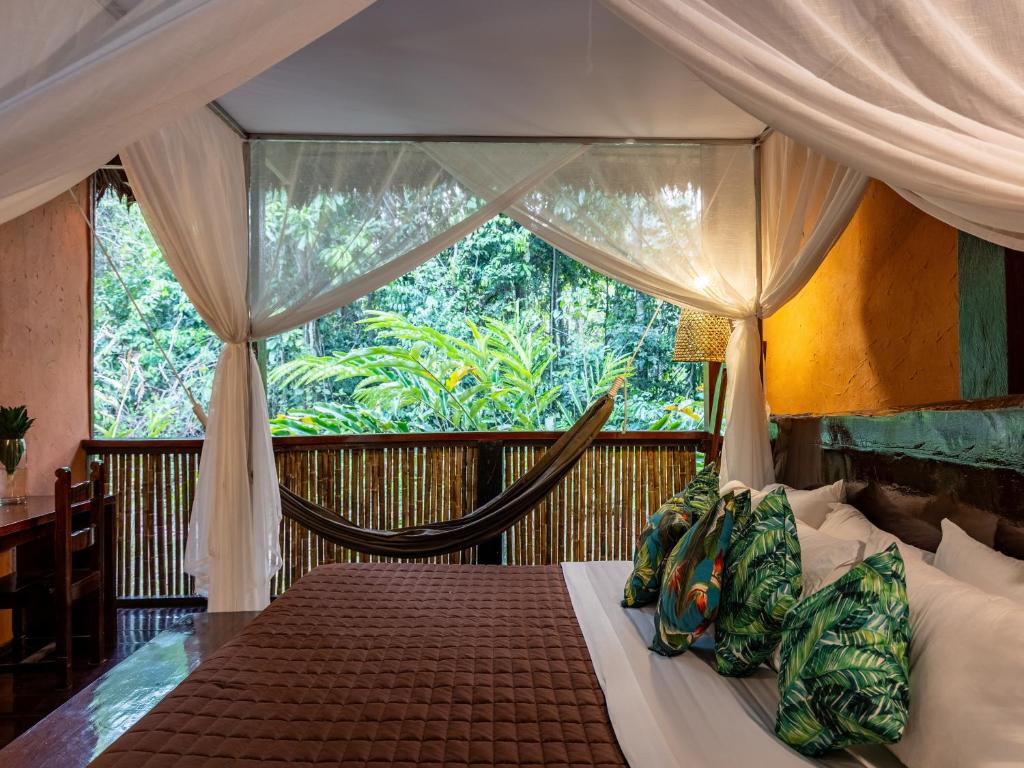
We glide down the Tambopata River on a wooden catamaran as the sky lightens, cool mist hangs over the water and in silence, we approach the clay bank – known as a ‘clay lick,’ – where dozens (sometimes hundreds) of macaws gather to eat the mineral-rich soil. It’s a surreal moment. The quiet morning suddenly bursts into life as scarlet, blue and yellow macaws and mealy parrots take off together, filling the sky with a cacophony of colour and noise. This isn’t just for show, the clay helps birds digest their mostly acidic fruit diet, making this one of the best places in the world to see these magnificent birds.
Later, we set out in search of the elusive giant river otter, one of the Amazon’s most charismatic predators, known for their playful antics and close family bonds. We wait for a few silent hours hoping to catch a glimpse, but just as hope dwindles and we decide to turn back, we spot a family hunting together. Their sleek bodies weave through the calm waters of the oxbow lake – a crescent-shaped lagoon filled with fish and perfect for hunting – diving and surfacing again and again, they pay us little mind before disappearing into the banks.
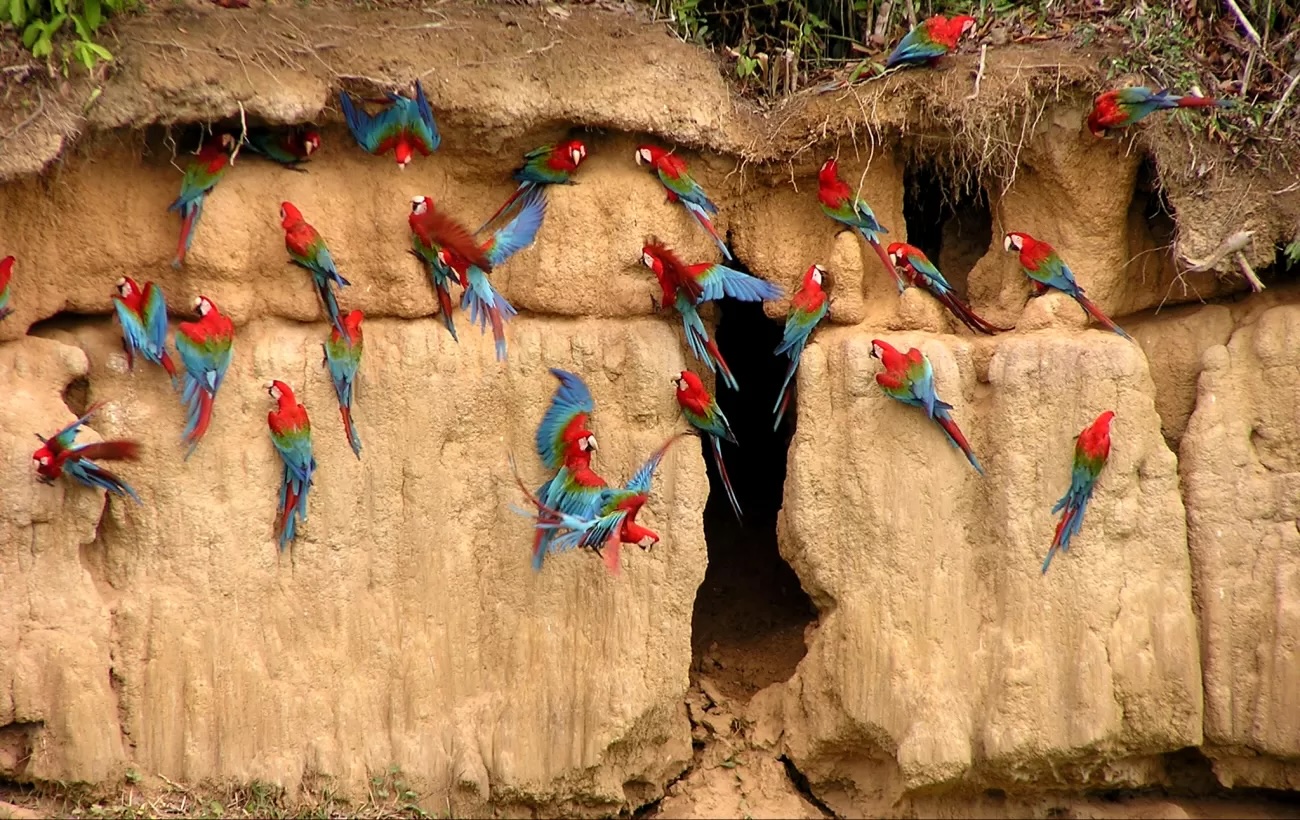
On our return, we also pass the unmistakable paw prints of a jaguar, fresh in the soft riverbank mud, a reminder that apex predators still roam freely here and this area, we are informed, is where most sightings occur. On this occasion we don’t see the gorgeous cats, but we aren’t bothered by this. In fact, we are glad to experience the luck of nature.
Back on foot, we follow a winding jungle trail under a towering canopy that includes a 500 year-old, 50 metre high moss-covered giant ceiba tree, its roots sprawling out for several metres, supporting hundreds of species of plants, animals and insect ecosystems. As we move on, a parrot snake slithers silently across our path, its scales catching the light.
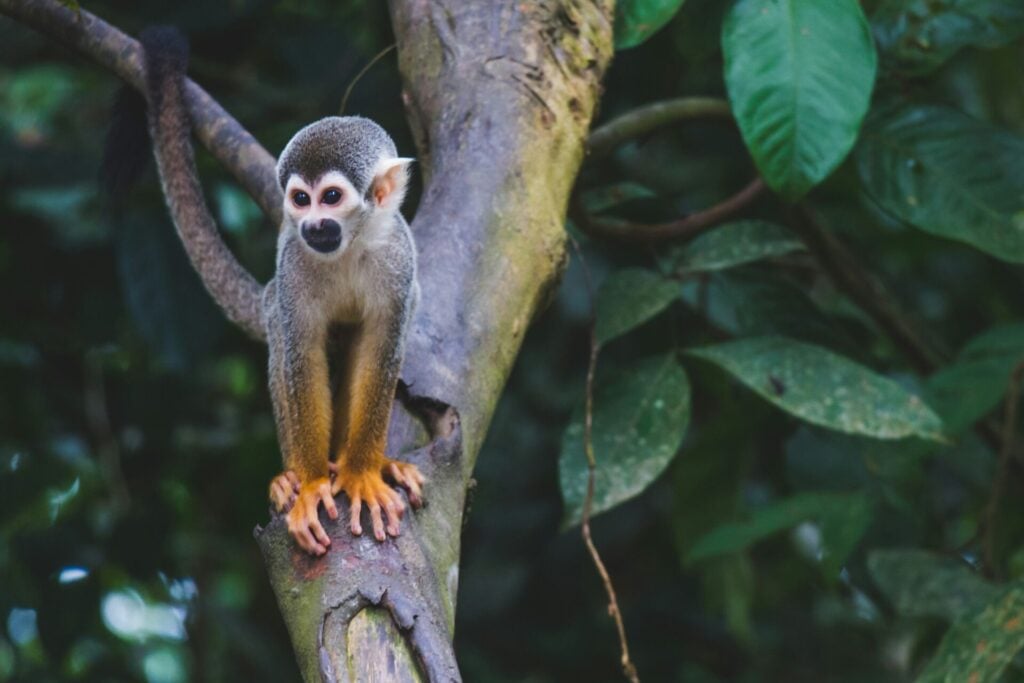
We spot howler monkeys hanging out in brazil nut trees, squirrel monkeys leaping between branches their long tails hanging in the air, and even a wild deer watches us shyly through the undergrowth. High in the branches, toucans clack and croak while bright blue butterflies flit through shafts of sunlight as we return to Posada Amazonas for lunch and an afternoon of relaxation.
At sunset, we climb Posada Amazonas’ 40 metre high canopy observation tower, to watch the sun dip over the Tambopata National Reserve at golden hour. From this vantage point, the Amazon unfolds endlessly. With it’s view of unbroken tree tops, the glint of the river below, and the occasional silhouette of macaws heading to roost in the evening light, it’s a magical moment.
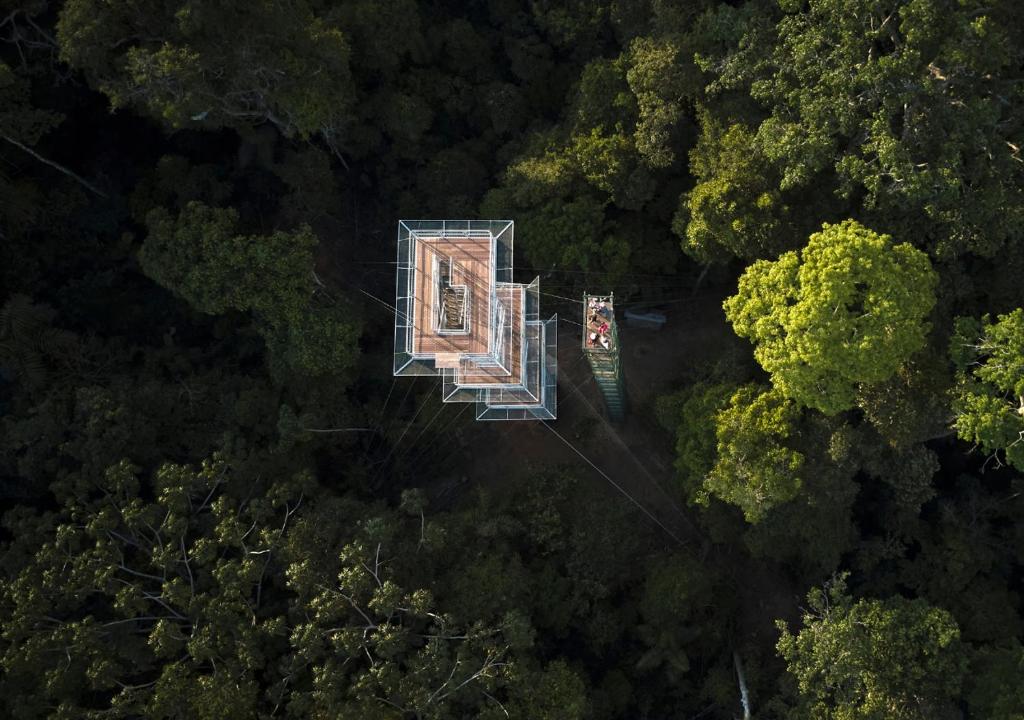
At the multi-award winning Rainforest Expeditions you are never alone. You trek in groups and are always accompanied by a trained member of staff whether it’s a day or night expedition. So, with headlamps on, our guide leads us on a night walk to discover the forest’s lesser-seen inhabitants. We were initially concerned about exploring after dark, but we soon learn that, to the contrary, a whole new world awaits when the sun goes down.
Within minutes we spot scorpions, tarantulas and banana spiders, weaving their incredible webs across the path. We meet curious frogs, iridescent insects, and more beetles than we could ever count, and learn when they are and aren’t a danger to humans. It’s common to fear the insect world but like most animals, many don’t react unless provoked so we watch them here without worry. It’s definitely a little eerie… but utterly exhilarating.
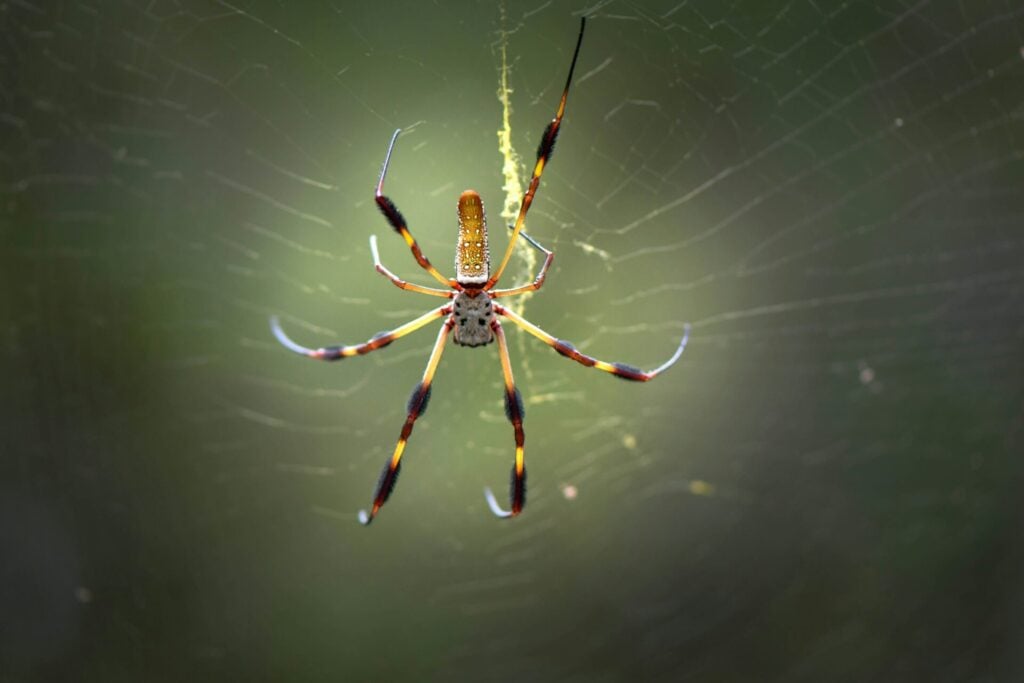
Travel That Gives Back
One of the most inspiring aspects of Posada Amazonas is its commitment to scientific research and community involvement. Every evening, guests are invited to attend short lectures and Q&As with Wired Amazon, a citizen science and conservation program powered by Rainforest Expeditions.
We learn how visitors can contribute to real-world biodiversity research, helping scientists discover new species, monitor camera traps, and understand how climate change is affecting the Amazon. The programs are impactful, grassroots collaborations between scientists, locals, and travellers. From camera trap footage of rare jungle cats to studies on pollinators, every guest becomes part of the greater purpose.
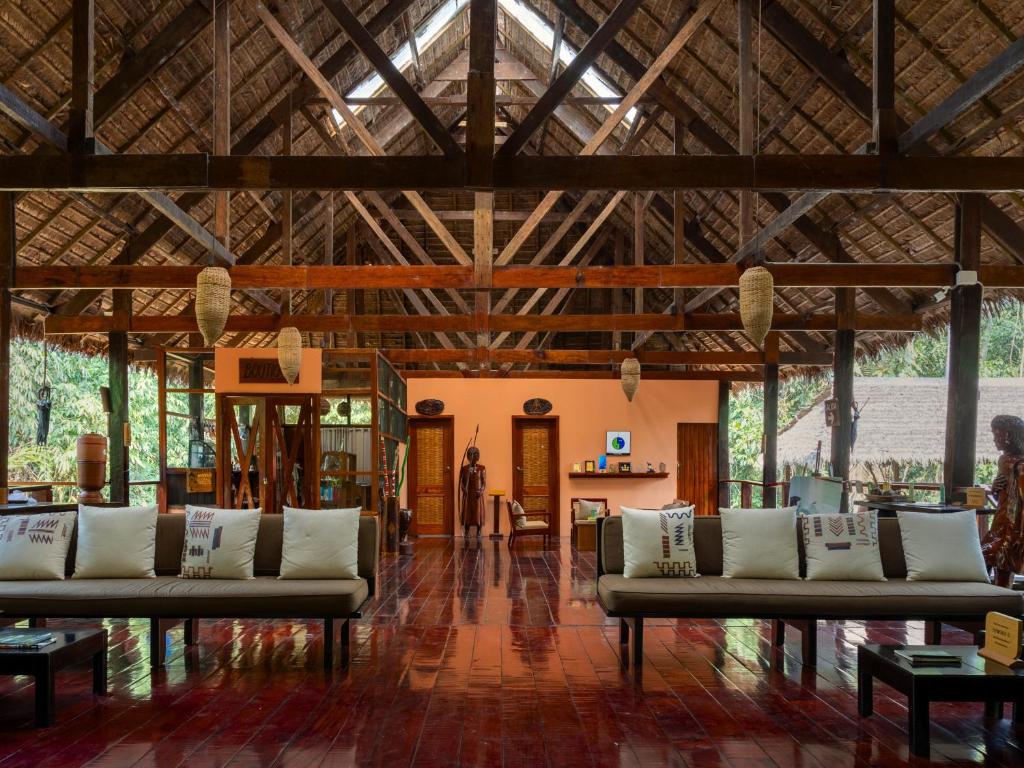
The Discovering New Species project, specifically ran at Posada Amazonas, is completely unique to the lodge. The team invites guests to become hands-on contributors to real science by helping biologists identify previously unknown insect species in the Amazon rainforest. Each night at Posada Amazonas, light traps are set up to attract moths, leafhoppers, treehoppers, and scorpion wasps (four insect families targeted for research) and samples are collected.
These samples are then sorted in an open-air lab, and selected specimens are sent for DNA barcoding at partner institutions like the Natural History Museum in Lima. Since 2016, over 31 new arthropod species have been discovered through this initiative and if a guest has participated in this finding, they are even given naming rights! This project combines tourism with legitimate scientific research, helping fill vital biodiversity gaps and contributing samples to the global BOLD barcode database. To date, more than 1,500 guests have participated in this project, which is part of Rainforest Expeditions’ award-winning Wired Amazon program.
The lodge’s partnership with the Ese Eja community also ensures that tourism here benefits the local communities. A portion of profits goes directly to the Infierno community – an indigenous Amazonian people who have lived in this region for generations – who also co-manage the lodge, lead some tours, and provide cultural experiences.
Comfort and Consciousness
Despite its remote location, Posada Amazonas balances eco-consciousness with comfort. Our biggest surprise was the luxuriousness of the lodge. Rooms are rustic yet beautifully designed, featuring thatched roofs, hardwood floors, and hammocks for lazy afternoons.
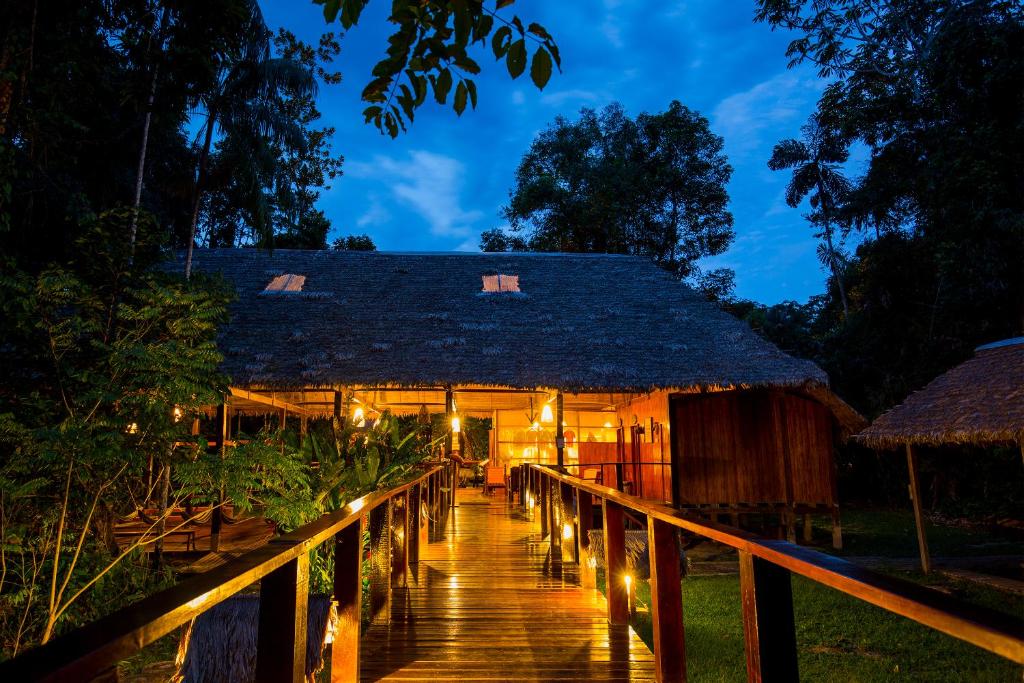
All meals are served buffet-style in the open-air dining room, with generous helpings of local, seasonal ingredients. Whether it’s fresh tropical fruits, warm quinoa stews, or crisp plantain chips, everything is thoughtfully prepared and delicious. And don’t worry if you have specific dietary requirements, they somehow cater to every need.
Unlimited snacks and hot drinks are available throughout the day in the reception area (because birdwatching works up an appetite) and it’s best not to keep snacks in your room, incase you attract some hungry visitors!
There are many ways to experience the Amazon, but few places match the soul, sustainability, and sheer wonder of Posada Amazonas. The Amazon may sprawl across a continent, but to us, its heart beats loudest in Peru and this lodge offers a rare chance to feel its rhythm up close and ethically.
How to get to Posada Amazonas
Fly to Puerto Maldonado from Lima or Cusco. Rainforest Expeditions arranges transfers, including the boat ride up the Tambopata River.
Best time to visit:
Dry season (May to October) for wildlife spotting; wet season (November to April) for lush greenery and fewer tourists.
Packages:
The 4-day experience includes guided excursions, full board, transport, and activities.
For more, visit www.rainforestexpeditions.com








